Temple of Literature - famous historical and cultural relic in Hanoi
Temple of Literature - Quoc Tu Giam is the first university in our country - a place that preserves the cultural and historical imprints of the capital of a thousand years of civilization. Currently, this relic has become an attractive tourist destination, attracting domestic and foreign tourists to visit.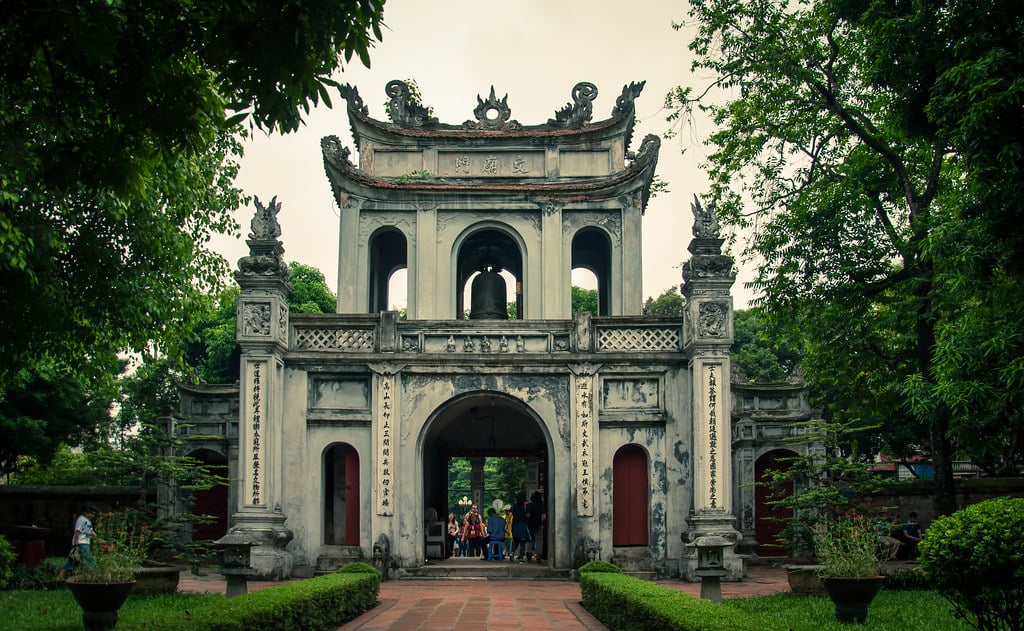 Temple of Literature - Quoc Tu Giam is located in Dong Da district and right in the middle of 4 bustling streets: Nguyen Thai Hoc, Temple of Literature, Quoc Tu Giam and Ton Duc Thang. You need to be careful because around the Temple of Literature there are many one-way streets. Temple of Literature - Quoc Tu Giam is the first National School in Vietnam. Here, many generations of talented people have been trained for the country. The Temple of Literature worships three wise kings of the nation: Ly Thanh Tong, Ly Nhan Tong and Le Thanh Tong.
Temple of Literature - Quoc Tu Giam is located in Dong Da district and right in the middle of 4 bustling streets: Nguyen Thai Hoc, Temple of Literature, Quoc Tu Giam and Ton Duc Thang. You need to be careful because around the Temple of Literature there are many one-way streets. Temple of Literature - Quoc Tu Giam is the first National School in Vietnam. Here, many generations of talented people have been trained for the country. The Temple of Literature worships three wise kings of the nation: Ly Thanh Tong, Ly Nhan Tong and Le Thanh Tong.
The relic is a "mirror" that reflects the spirit of studiousness, respect for talented people and the studious tradition of our nation. Temple of Literature - Quoc Tu Giam is a famous and typical Confucian relic, with great value in art - aesthetics - architecture.
When visiting here, you will admire many valuable documents and artifacts. Especially the 82 doctoral steles - artifacts once recognized by UNESCO as a "World Documentary Heritage". Currently, the Temple of Literature - Quoc Tu Giam has become an extremely interesting cultural tourist destination.
With its cultural and historical values, in 1962, this place was classified as a National Monument.
In 1070, the Temple of Literature was built under the reign of King Ly Thanh Tong. Initially, this was the place to worship Tu Pham, Confucius, and Chu Cong. In 1076, King Ly Nhan Tong built Quoc Tu Giam next door, a place to teach the king's children and noble families. During the reign of King Tran Thai Tong, this place was renamed Quoc Hoc Academy, accepting to teach children of commoners with outstanding talents. During the reign of King Le Thanh Tong, at the Temple of Literature - Quoc Tu Giam began to erect stele of those who passed doctorates. During the Nguyen Dynasty, Quoc Tu Giam was established in Hue. The Temple of Literature was renovated and later renamed Hanoi Temple of Literature. In 1947, the French colonialists fired cannons, collapsing the house, leaving behind the foundation, four stone pillars, and two columns.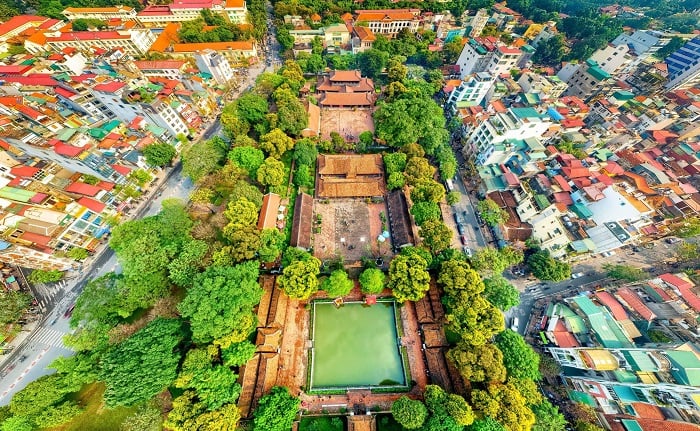 This relic complex is about 54,331 square meters wide, including many diverse works such as: Ho Van, Temple of Literature, Quoc Tu Giam, Giam garden, Khue Van Cac... Surrounding the campus are brick paintings tinged with time. . Covering the Temple of Literature is the royal architecture of the early Nguyen Dynasty. The subject areas have a symmetrical layout for each area and each layer according to the traditional North - South axis.
This relic complex is about 54,331 square meters wide, including many diverse works such as: Ho Van, Temple of Literature, Quoc Tu Giam, Giam garden, Khue Van Cac... Surrounding the campus are brick paintings tinged with time. . Covering the Temple of Literature is the royal architecture of the early Nguyen Dynasty. The subject areas have a symmetrical layout for each area and each layer according to the traditional North - South axis.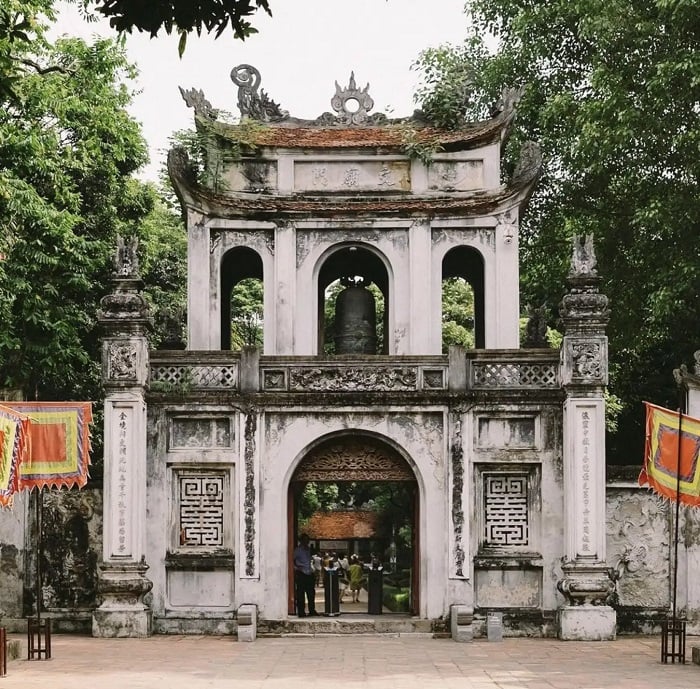 Temple of Literature is the part of the Tam Quan gate outside the relic site. Temple of Literature consists of 3 doors and 2 floors. The upper floor has the three words Van Mieu Mon in ancient Chinese characters. In front of the Tam Quan gate are two steles on both sides with four ceremonial pillars in the middle. Van Mieu Mon exudes solemnity and dignity.
Temple of Literature is the part of the Tam Quan gate outside the relic site. Temple of Literature consists of 3 doors and 2 floors. The upper floor has the three words Van Mieu Mon in ancient Chinese characters. In front of the Tam Quan gate are two steles on both sides with four ceremonial pillars in the middle. Van Mieu Mon exudes solemnity and dignity.
Ho Van is also known as Giam lake or Minh Duong lake. The lake is located right in front of the gate of the Temple of Literature relic site. Van Lake is quite large, in the middle of the lake is Kim Chau mound. On the mound is Phan Thuy Duong - the place where literary commentary sessions of ancient Confucian scholars took place. Located on the western wall of the Temple of Literature, Giam garden is home to an octagonal house, lake, ornamental plants and many other miniatures. The garden is a place to visit, relax and hold attractive cultural activities.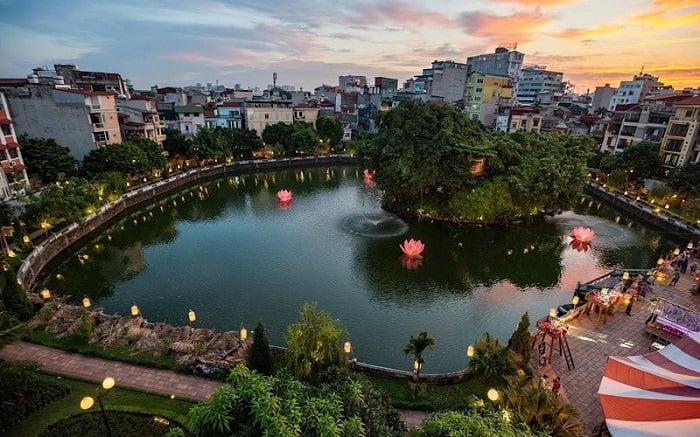 Dai Trung Mon is the second gate of the Temple of Literature - Quoc Tu Giam relic site. This work consists of 3 compartments, built on a high brick foundation with funny nose tiles designed in the style of an ancient communal house roof. In front and behind the Dai Trung Mon area is an extremely large space with long parallel roads, trees, and open lakes. All create a quiet, peaceful scene in the middle of bustling Hanoi.
Dai Trung Mon is the second gate of the Temple of Literature - Quoc Tu Giam relic site. This work consists of 3 compartments, built on a high brick foundation with funny nose tiles designed in the style of an ancient communal house roof. In front and behind the Dai Trung Mon area is an extremely large space with long parallel roads, trees, and open lakes. All create a quiet, peaceful scene in the middle of bustling Hanoi.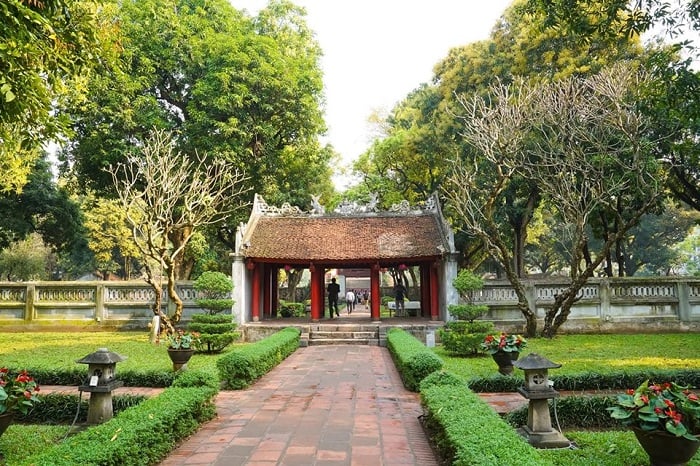 Khue Van Cac was built in 1805 by Governor Nguyen Van Thanh during the Nguyen Dynasty. This is a square floor with 8 roofs nearly 9 meters high with 4 upper roofs and 4 lower roofs. Khue Van Cac is located on a square ground, each side is about 6.8 meters long. This project impresses with its super unique ancient-style architecture.
Khue Van Cac was built in 1805 by Governor Nguyen Van Thanh during the Nguyen Dynasty. This is a square floor with 8 roofs nearly 9 meters high with 4 upper roofs and 4 lower roofs. Khue Van Cac is located on a square ground, each side is about 6.8 meters long. This project impresses with its super unique ancient-style architecture. 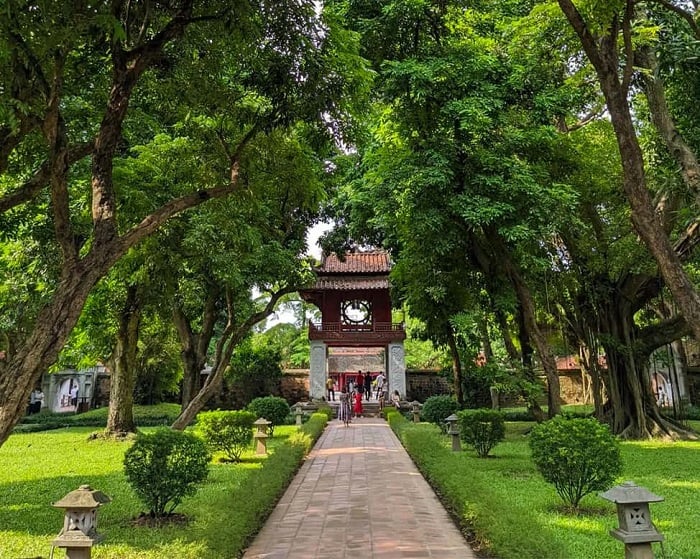 On the lower floor are 4 square brick pillars intricately carved with patterns. The upper floor is painted with gilded vermilion, with two layers of brilliant red tiled roofs overlapping each other. The round windows on the upper floor create a striking feature, like a shining star.
On the lower floor are 4 square brick pillars intricately carved with patterns. The upper floor is painted with gilded vermilion, with two layers of brilliant red tiled roofs overlapping each other. The round windows on the upper floor create a striking feature, like a shining star.
Doctor's Garden is a must-see sightseeing location at the Temple of Literature - Quoc Tu Giam. The 82 doctoral steles here are extremely sophisticated sculptures with spiritual significance. These steles are placed on the backs of stone turtles, with the information of 82 valedictorians of many dynasties of Vietnam recorded on the steles. On March 9, 2010, these 82 stone steles were recognized by UNESCO as a World Documentary Heritage. 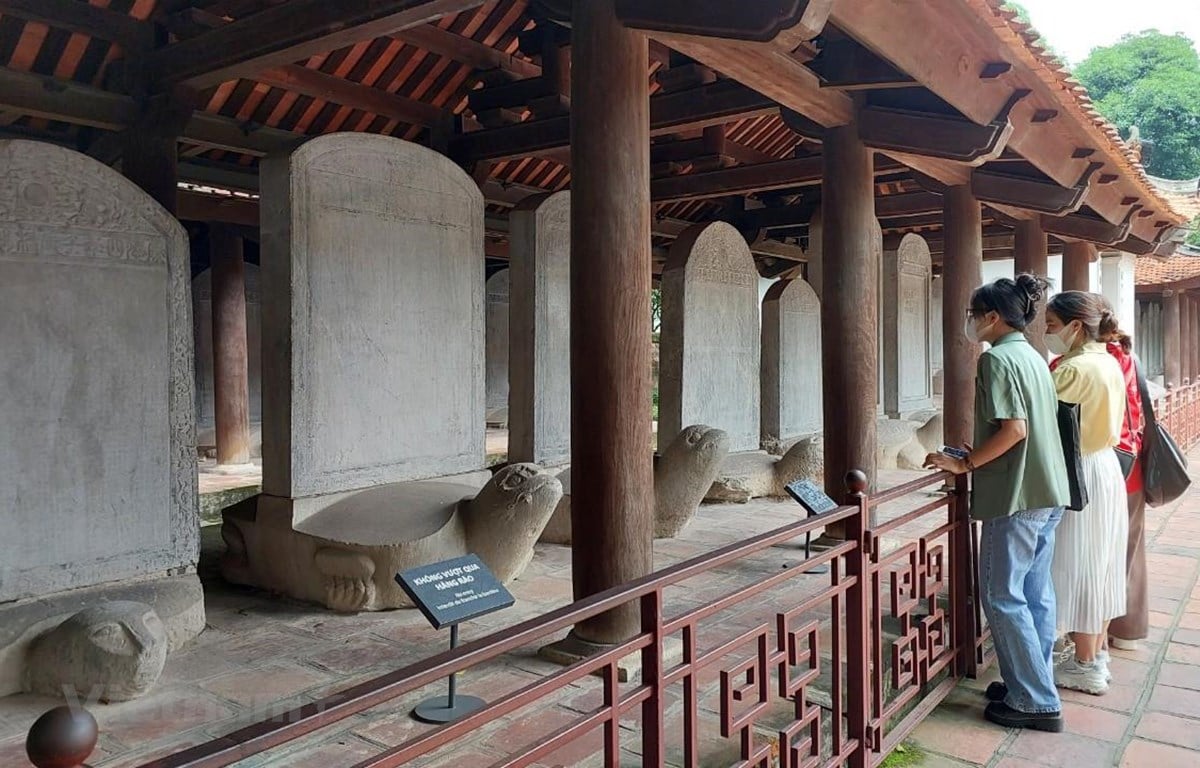 Thien Quang well is located next to the doctoral stele area and right behind Khue Van Cac. The well is square in shape, symbolizing the ground. The well is also known as Ao Van. The ancients built this structure with the intention of being a place to receive all the essence of the universe and illuminate knowledge.
Thien Quang well is located next to the doctoral stele area and right behind Khue Van Cac. The well is square in shape, symbolizing the ground. The well is also known as Ao Van. The ancients built this structure with the intention of being a place to receive all the essence of the universe and illuminate knowledge.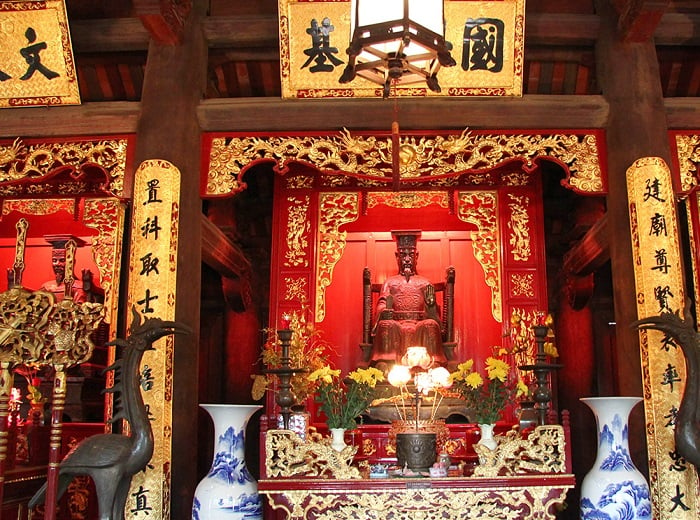 Located at the end of the relic site is Khai Thanh Temple. This place worships Confucius's parents - Thuc Luong Ngot & Nhan Thi. Previously, Khai Thanh Temple used to be a residential area with 150 rooms for students. In 1946, the French colonialists bombarded Khai Thanh Temple, the structure was completely destroyed. Later, the temple was built and preserved to this day.
Located at the end of the relic site is Khai Thanh Temple. This place worships Confucius's parents - Thuc Luong Ngot & Nhan Thi. Previously, Khai Thanh Temple used to be a residential area with 150 rooms for students. In 1946, the French colonialists bombarded Khai Thanh Temple, the structure was completely destroyed. Later, the temple was built and preserved to this day.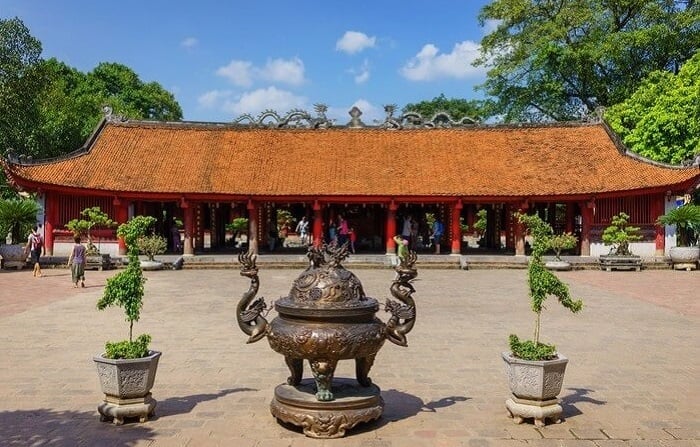
Dai Thanh Mon is a building with 3 tile-roofed compartments and 2 sturdy porch columns in the front and back. Through Dai Thanh Mon is Dai Bai Duong (shrine area). In Dai Bai, there are many precious horizontal panels, incense altars, a pair of ancient cranes and a large bell cast in the year Canh Hung 1768. Dai Bai Duong consists of 9 rooms, where ceremonies took place during the period. Spring and autumn worship in ancient times.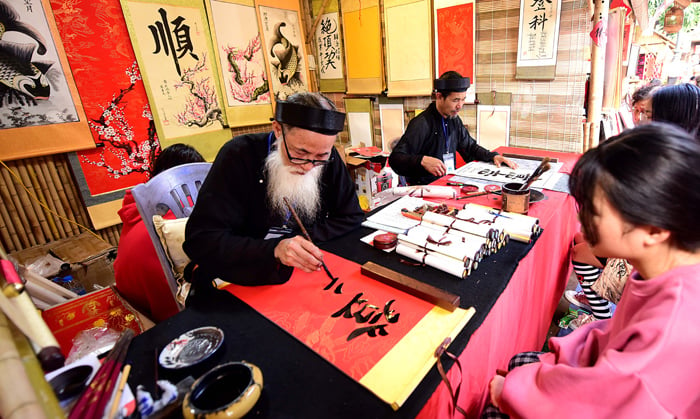 Through many years and ups and downs of history, the Temple of Literature - Quoc Tu Giam still retains artifacts and great architectural and cultural values. This is a work that symbolizes the quintessence of education and the fine traditions of the Vietnamese people.
Through many years and ups and downs of history, the Temple of Literature - Quoc Tu Giam still retains artifacts and great architectural and cultural values. This is a work that symbolizes the quintessence of education and the fine traditions of the Vietnamese people.








































